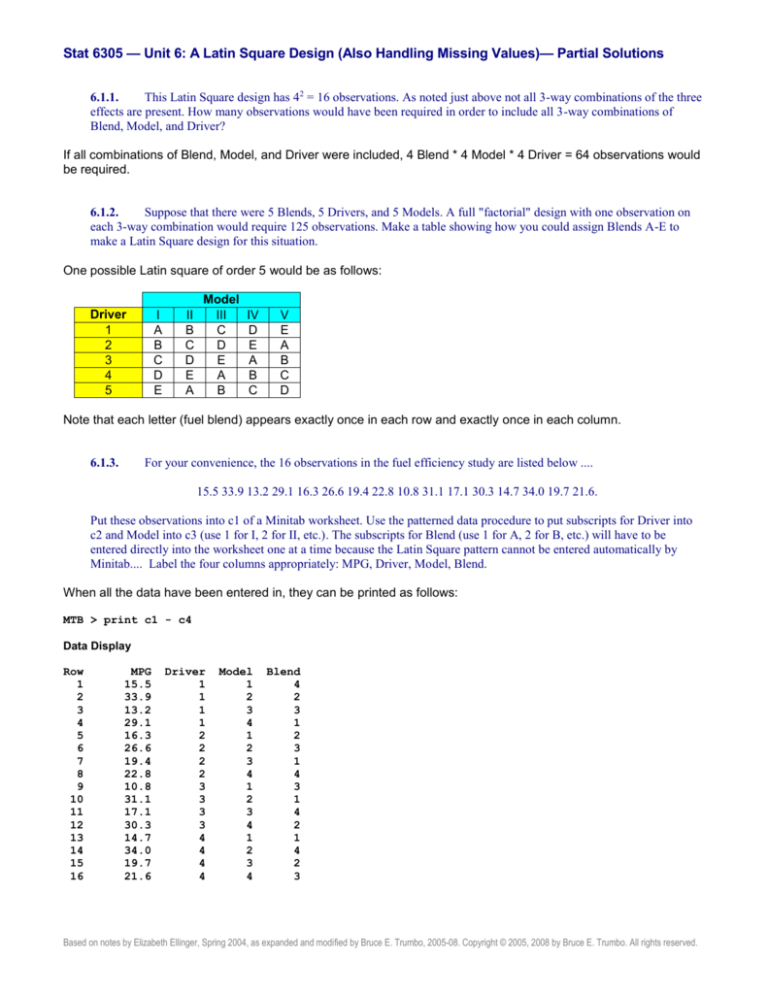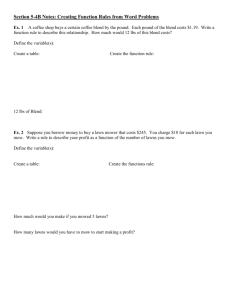
Stat 6305 — Unit 6: A Latin Square Design (Also Handling Missing Values)— Partial Solutions
6.1.1.
This Latin Square design has 42 = 16 observations. As noted just above not all 3-way combinations of the three
effects are present. How many observations would have been required in order to include all 3-way combinations of
Blend, Model, and Driver?
If all combinations of Blend, Model, and Driver were included, 4 Blend * 4 Model * 4 Driver = 64 observations would
be required.
6.1.2.
Suppose that there were 5 Blends, 5 Drivers, and 5 Models. A full "factorial" design with one observation on
each 3-way combination would require 125 observations. Make a table showing how you could assign Blends A-E to
make a Latin Square design for this situation.
One possible Latin square of order 5 would be as follows:
Driver
1
2
3
4
5
I
A
B
C
D
E
II
B
C
D
E
A
Model
III
C
D
E
A
B
IV
D
E
A
B
C
V
E
A
B
C
D
Note that each letter (fuel blend) appears exactly once in each row and exactly once in each column.
6.1.3.
For your convenience, the 16 observations in the fuel efficiency study are listed below ....
15.5 33.9 13.2 29.1 16.3 26.6 19.4 22.8 10.8 31.1 17.1 30.3 14.7 34.0 19.7 21.6.
Put these observations into c1 of a Minitab worksheet. Use the patterned data procedure to put subscripts for Driver into
c2 and Model into c3 (use 1 for I, 2 for II, etc.). The subscripts for Blend (use 1 for A, 2 for B, etc.) will have to be
entered directly into the worksheet one at a time because the Latin Square pattern cannot be entered automatically by
Minitab.... Label the four columns appropriately: MPG, Driver, Model, Blend.
When all the data have been entered in, they can be printed as follows:
MTB > print c1 - c4
Data Display
Row
1
2
3
4
5
6
7
8
9
10
11
12
13
14
15
16
MPG
15.5
33.9
13.2
29.1
16.3
26.6
19.4
22.8
10.8
31.1
17.1
30.3
14.7
34.0
19.7
21.6
Driver
1
1
1
1
2
2
2
2
3
3
3
3
4
4
4
4
Model
1
2
3
4
1
2
3
4
1
2
3
4
1
2
3
4
Blend
4
2
3
1
2
3
1
4
3
1
4
2
1
4
2
3
Based on notes by Elizabeth Ellinger, Spring 2004, as expanded and modified by Bruce E. Trumbo, 2005-08. Copyright © 2005, 2008 by Bruce E. Trumbo. All rights reserved.
Stat 6305 — Unit 6: Partial Solutions
2 of 11
6.1.4.
Because this experiment was done by an oil company it is reasonable to assume that the main issue is whether
there are differences among the four Blends, and that Blend is a fixed effect because four particular blends are currently
under study. Also, it may be reasonable to assume that Models of car and Drivers were chosen at random from among
available models and drivers. Subject to these assumptions, write the model for this experiment. In specifying the range of
the subscripts for Driver you can use "i = 1, 2, 3, 4." and for Model you can use "j = 1, 2, 3, 4." However, for Blend you
need to say something like "the 4 values of the Blend subscript k are assigned to the 16 observations according to a Latin
Square design," in order to make it clear that there are only 16 observations.
Here is the model for this experiment (with a slightly different approach to specify subscripts of the Latin square
design):
yijk = + Bi + Cj +k + eijk, where i, j, k = 1, 2, 3, 4; with observations in 16 cells, assigned according to a Latin
square design of order 4. Restriction: k k = 0. Distributions: Bi ~ N(0, B2), Cj ~ N(0, C2), eijk ~ N(0, 2), where
all of the random variables Bi, Cj and eijk are mutually independent.
Also, denotes the grand mean, denotes the (fixed) blend effect, B denotes the (random) Driver effect,
C denotes the (random) Model effect, and eijk denote random error, independent and identically distributed N(0, ).
6.1.5.
The design space of this Latin Square is really a very carefully chosen subset of a cube. There are 43 = 64
possible combinations of the levels of the three factors, of which only 16 are observed. The table at the beginning of this
unit can be viewed as a two-dimensional representation of the cube with dimensions z = Driver (height), y = Model
(width), and x = Blend (depth). Minitab makes three-dimensional scatterplots; in Minitab 14 they can be conveniently
rotated.
GRAPH 3D Scatterplot . Groups, z='Driver", y='Model', x='Blend', Group=Blend; Data view: symbols
and lines. TOOLS Toolbars 3D Graph, rotate about appropriate axes.
In Minitab 14, use the tools to rotate such a plot so that, first, the y-axis is perpendicular to your view, and then the x axis.
Also, with some fussing, you should be able to orient the cube to match the data table.
3D Scatterplot of Driver vs Model vs Blend
3D Scatterplot of Driver vs Model vs Blend
Blend
1
2
3
4
Blend
1
2
3
4
4
4
3
3
Dr iver
Dr iver
2
2
4
1
3
1
2
Blend
2
3
4
1
M odel
21 4
4
3
1
3
2
M odel
3D Scatterplot of Driver vs Model vs Blend
1
Blend
3D Scatterplot of Driver vs Model vs Blend
Blend
1
2
3
4
Blend
1
2
3
4
1
4
2
3
Dr iver
M odel
2
3
1
21 1
4
3
Blend
2
3
M odel
4
Dr iver
4
1
2
3
4
1
2
3
4
Blend
Based on notes by Elizabeth Ellinger, Spring 2004, as expanded and modified by Bruce E. Trumbo, 2005-08. Copyright © 2005, 2008 by Bruce E. Trumbo. All rights reserved.
Stat 6305 — Unit 6: Partial Solutions
3 of 11
6.2.1.
Use the following procedure and the stacked-subscripted data to make a table that resembles the original data
table of Section 1. Now, by hand, make a table similar to the original data table, except that the rows are Drivers, the
columns are Blends, and the labels within cells are Roman numerals I-IV designating Models. Verify your result in
Minitab with a procedure similar to the one shown just above. Repeat (both by hand and in Minitab) for a table in which
Drivers are designated within the cells.
Using the table command in Minitab to display the data in a format similar to the original table results in the
following:
MTB > table 'Driver' 'Model';
SUBC> data 'MPG' 'Blend'.
Tabulated statistics: Driver, Model
Rows: Driver
1
2
3
4
Columns: Model
1
2
3
4
15.5
33.9
13.2
29.1
4
2
3
1
16.3
26.6
19.4
22.8
2
3
1
4
10.8
31.1
17.1
30.3
3
1
4
2
14.7
34.0
19.7
21.6
1
4
2
3
Cell Contents:
MPG
Blend
:
:
DATA
DATA
Another arrangement of the data, with roman numerals designations for Model, is as follows:
Blends
Driver
A
B
C
D
1
IV 29.1
II 33.9
III 13.2
I 15.5
2
III 19.4
I 16.3
II 26.6
IV 22.8
3
II 31.1
IV 30.3
I 10.8
III 17.1
4
I 14.7
III 19.7
IV 21.6
II 34.0
Based on notes by Elizabeth Ellinger, Spring 2004, as expanded and modified by Bruce E. Trumbo, 2005-08. Copyright © 2005, 2008 by Bruce E. Trumbo. All rights reserved.
Stat 6305 — Unit 6: Partial Solutions
4 of 11
The Minitab representation of this table is as follows:
Tabulated statistics: Driver, Blend
Rows: Driver
1
2
3
4
Columns: Blend
1
2
3
4
4
2
3
1
29.1
33.9
13.2
15.5
3
1
2
4
19.4
16.3
26.6
22.8
2
4
1
3
31.1
30.3
10.8
17.1
1
3
4
2
14.7
19.7
21.6
34.0
Cell Contents:
Model
MPG
:
:
DATA
DATA
The Minitab representation of yet another arrangement of the data, with Drivers designated within the cells, is as
follows:
Tabulated statistics: Blend, Model
Rows: Blend
1
2
3
4
Columns: Model
1
2
3
4
4
3
2
1
14.7
31.1
19.4
29.1
2
1
4
3
16.3
33.9
19.7
30.3
3
2
1
4
10.8
26.6
13.2
21.6
1
4
3
2
15.5
34.0
17.1
22.8
Cell Contents:
Driver
MPG
:
:
DATA
DATA
Based on notes by Elizabeth Ellinger, Spring 2004, as expanded and modified by Bruce E. Trumbo, 2005-08. Copyright © 2005, 2008 by Bruce E. Trumbo. All rights reserved.
Stat 6305 — Unit 6: Partial Solutions
5 of 11
6.2.2.
Try to use Minitab's balanced ANOVA procedure to analyze this block design. What happens? (A Latin Square
is "balanced" in the sense that the four subspaces corresponding to the three factors and error are orthogonal. In Minitab's
"Balanced ANOVA" all combinations of treatment levels must have the same number of observations; here 16
frequencies are 1 and 64 – 16 = 48 are 0.)
Attempting to use the balanced ANOVA to analyze this design results in the following error message from Minitab:
(Proper English would be 'imbalance' rather than 'unbalance', but one properly speaks of 'unbalanced designs.')
* ERROR * Unbalanced design. A cross tabulation of your factors will show
* where the unbalance exists.
6.2.3.
Repeat the GLM procedure shown in this section to obtain the EMS table and components of variance, and
make a column of residuals. (Notice that we have not used the restrict subcommand because it is not available with GLM;
for a Latin Square design this causes no difficulty.)
The output of the GLM procedure is as follows:
General Linear Model: MPG versus Driver, Model, Blend
Factor
Driver
Model
Blend
Type
random
random
fixed
Levels
4
4
4
Values
1, 2, 3, 4
1, 2, 3, 4
1, 2, 3, 4
Analysis of Variance for Fuel Eff, using Adjusted SS for Tests
Source
Driver
Model
Blend
Error
Total
DF
3
3
3
6
15
S = 1.99202
Seq SS
5.897
736.912
108.982
23.809
875.599
Adj SS
5.897
736.912
108.982
23.809
R-Sq = 97.28%
Adj MS
1.966
245.637
36.327
3.968
F
0.50
61.90
9.15
P
0.699
0.000
0.012
Orthogonal design so Seq SS = Adj SS
R-Sq(adj) = 93.20%
Expected Mean Squares, using Adjusted SS
1
2
3
4
Source
Driver
Model
Blend
Error
Expected Mean
Square for Each
Term
(4) + 4.0000 (1)
(4) + 4.0000 (2)
(4) + Q[3]
(4)
Mathematical Expressions
2 + 4B2
2 + 4C2
2 + 4
2
(a) What mean square is in the denominator of each F-ratio. How do the EMSs lead you to the conclusion that this is
correct?
See the mathematical expressions added to the EMS table just above. If there is no Blend () effect so that ,
then EMS(Blend) = 2 + 42 = EMS(Error), so MS(Blend) and MS(Error) have the same expected value. This
indicates that they can be used as numerator and denominator of an F-statistic. Similar arguments can be made
concerning the F-ratios to test for the random Driver and Model effects. The Error Terms table just below
summarizes the result that MS(Error) is used in the denominator of all three F-tests done in the ANOVA table.
Error Terms for Tests, using Adjusted SS
1
2
3
Source
Driver
Model
Blend
Error DF
6.00
6.00
6.00
Error MS
3.968
3.968
3.968
Synthesis
of Error
MS
(4)
(4)
(4)
Based on notes by Elizabeth Ellinger, Spring 2004, as expanded and modified by Bruce E. Trumbo, 2005-08. Copyright © 2005, 2008 by Bruce E. Trumbo. All rights reserved.
Stat 6305 — Unit 6: Partial Solutions
6 of 11
Variance Components, using Adjusted SS
Estimated
Value
-0.5006
60.4173
3.9681
Source
Driver
Model
Error
(b) What is strange about the component of variance for Driver? How do you interpret this result in practice?
The estimated value of B2 (component of variance for Driver) is negative. We know that a variance cannot actually
be negative. We conclude that the variance component for Driver is negligibly small. (These drivers must have
been professionals carefully trained to use similar driving styles during the test. In ordinary driving, differences in
driving styles can have a major impact on MPG.)
(c) What is the P-value of the Anderson-Darling test for normality of the residuals, and how do you interpret it?
Probability Plot of Residuals
Normal - 95% CI
99
Mean
StDev
N
AD
P-Value
95
90
-1.11022E-15
1.260
16
0.136
0.970
Percent
80
70
60
50
40
30
20
10
5
1
-4
-3
-2
-1
0
1
Residuals
2
3
4
5
The Anderson-Darling statistic has a large P-value = .970. This indicates that the null hypothesis of normality of the
data cannot be rejected.
6.2.4.
Multiple comparison procedures for a Latin Square design. We have established that there are significant
differences among the Blends. By hand, establish the pattern of significant differences using Fisher's LSD procedure and
Tukey's HSD procedure (both at the 5% level). The formulas are similar to the ones for a one-way ANOVA, except that
you must use MS(Error) from the ANOVA table as the variance estimate (i.e., instead of s w2) and n = t. (The exact
formula for LSD is given in O/L 6e, page 1146.)
Based on notes by Elizabeth Ellinger, Spring 2004, as expanded and modified by Bruce E. Trumbo, 2005-08. Copyright © 2005, 2008 by Bruce E. Trumbo. All rights reserved.
Stat 6305 — Unit 6: Partial Solutions
7 of 11
The Tukey comparisons using Minitab GLM are as follows:
Tukey 95.0% Simultaneous Confidence Intervals
Response Variable MPG
All Pairwise Comparisons among Levels of Blend
Blend = 1 subtracted from:
Blend
2
3
4
Lower
-3.41
-10.41
-6.11
Blend = 2
Blend
3
4
Upper
6.3554
-0.6446
3.6554
+---------+---------+---------+-----(-------*--------)
(-------*-------)
(-------*-------)
+---------+---------+---------+------12.0
-6.0
0.0
6.0
subtracted from:
Lower
-11.88
-7.58
Blend = 3
Blend
4
Center
1.475
-5.525
-1.225
Center
-7.000
-2.700
Upper
-2.120
2.180
+---------+---------+---------+-----(-------*-------)
(--------*-------)
+---------+---------+---------+------12.0
-6.0
0.0
6.0
subtracted from:
Lower
-0.5804
Center
4.300
Upper
9.180
+---------+---------+---------+-----(-------*-------)
+---------+---------+---------+------12.0
-6.0
0.0
6.0
Tukey Simultaneous Tests
Response Variable MPG
All Pairwise Comparisons among Levels of Blend
Blend = 1 subtracted from:
Blend
2
3
4
Difference
of Means
1.475
-5.525
-1.225
Blend = 2
Blend
3
4
Blend
4
T-Value
1.047
-3.922
-0.870
Adjusted
P-Value
0.7307
0.0297
0.8204
T-Value
-4.970
-1.917
Adjusted
P-Value
0.0100
0.3136
T-Value
3.053
Adjusted
P-Value
0.0808
subtracted from:
Difference
of Means
-7.000
-2.700
Blend = 3
SE of
Difference
1.409
1.409
1.409
SE of
Difference
1.409
1.409
subtracted from:
Difference
of Means
4.300
SE of
Difference
1.409
Descriptive Statistics: MPG
Variable
FuelEff
Blend
1
2
3
4
Mean
23.58
25.05
18.05
22.35
Significant differences according to Tukey's HSD method are printed in red. The order of the means from smallest
to largest is 3, 4, 1, 2. Linking codes for means that do not differ, we get the following underline diagram:
3 4 1 2. Blends 1 and 2 have better MPG than Blend 3, but Blend 4 cannot be distinguished from other blends.
–––
———
Based on notes by Elizabeth Ellinger, Spring 2004, as expanded and modified by Bruce E. Trumbo, 2005-08. Copyright © 2005, 2008 by Bruce E. Trumbo. All rights reserved.
Stat 6305 — Unit 6: Partial Solutions
8 of 11
Hand calculations for Tukey HSD and Fisher LSD methods of multiple comparisons.
Fisher: LSD = t*[2 MS(Error) / t ]1/2 = 2.447 [2(3.968)/4]1/2 = 3.467, where t* cuts off the top 2.5%
of Student's t distribution with df = df(Error) = 6.
|18.05 – 22.35| = 4.30 > 3.467, so Blends 3 and 4 differ;
|25.05 – 22.35| = 2.70 < 3.467, so Blends 1, 2 and 4 do not differ.
3 4 1 2.
Tukey: HSD = q*[MS(Error) / t ]1/2 = 4.90 [3.968 / 4]1/2 = 4.880, where q* cuts off the top 5% of the Studentized range
distribution for 4 treatment groups and df = 6.
So Blends 3 and 4 do not differ, and so on. The underline diagram is the same as we deduced from Minitab.
We leave it to you to verify all necessary pairwise comparisons.
Notice that the length of the MInitab CIs is 2(4.880) = 9.76.
For example, the CI comparing Blends 2 and 3 has length –2.120 – (–11.88) = 9.76.
Because LSD < HSD, the Fisher method is more aggressive in declaring differences. On the other hand the more
conservative Tukey method carries a 5% error rate for the simultaneous comparisons of all C(4, 2) = 4!/(2! 2!) = 6
possible pairs of 4 Blends. For the Fisher method, a 5% error rate attaches to each individual paired comparison.
6.2.5.
Suppose that the MPG value for Driver 3/ Model II is missing. Copy c1 'MPG' to c11 and name the copied column
'MPG_M'. Replace the appropriate observation with a * (the asterisk is Minitab's symbol for a missing observation), and run
glm c11 = c2 c3 c4. How can you tell from the output that the Latin square design with a missing value is not an
orthogonal design? Try running both glm c11 = c2 c4 c3 and glm c11 = c4 c2 c3. What changes and what remains
the same? Interpret Minitab's (approximate) F-ratios.
The output from the GLM procedure glm c7 = c2 c3 c4 is as follows:
General Linear Model: Fuel MPG_M versus Driver, Model, Blend
Factor
Driver
Model
Blend
Type
random
random
fixed
Levels
4
4
4
Values
1, 2, 3, 4
1, 2, 3, 4
1, 2, 3, 4
Analysis of Variance for Fuel Eff_M, using Adjusted SS for Tests
Source
Driver
Model
Blend
Error
Total
DF
3
3
3
5
14
S = 1.80083
Seq SS
25.138
634.486
116.334
16.215
792.173
Adj SS
8.832
645.669
116.334
16.215
R-Sq = 97.95%
Adj MS
2.944
215.223
38.778
3.243
F
0.91
66.37
11.96
P
0.500
0.000
0.010
R-Sq(adj) = 94.27%
Notice that df(Error) = 5 now. A nonorthogonal design results in Sequential SS that are not the same as
Adjusted SS.
The output from the GLM procedure glm c7 = c2 c4 c3 is as follows:
General Linear Model: Fuel Eff_M versus Driver, Blend, Model
Factor
Driver
Blend
Model
Type
random
fixed
random
Levels
4
4
4
Values
1, 2, 3, 4
1, 2, 3, 4
1, 2, 3, 4
Analysis of Variance for Fuel Eff_M, using Adjusted SS for Tests
Based on notes by Elizabeth Ellinger, Spring 2004, as expanded and modified by Bruce E. Trumbo, 2005-08. Copyright © 2005, 2008 by Bruce E. Trumbo. All rights reserved.
Stat 6305 — Unit 6: Partial Solutions
Source
Driver
Blend
Model
Error
Total
DF
3
3
3
5
14
Seq SS
25.138
105.151
645.669
16.215
792.173
S = 1.80083
Adj SS
8.832
116.334
645.669
16.215
R-Sq = 97.95%
Adj MS
2.944
38.778
215.223
3.243
9 of 11
F
0.91
11.96
66.37
P
0.500
0.010
0.000
R-Sq(adj) = 94.27%
The output from the GLM procedure glm c7=c4 c2 c3 is as follows:
General Linear Model: Fuel Eff_M versus Blend, Driver, Model
Factor
Blend
Driver
Model
Type
fixed
random
random
Levels
4
4
4
Values
1, 2, 3, 4
1, 2, 3, 4
1, 2, 3, 4
Analysis of Variance for Fuel Eff_M, using Adjusted SS for Tests
Source
Blend
Driver
Model
Error
Total
DF
3
3
3
5
14
S = 1.80083
Seq SS
101.057
29.233
645.669
16.215
792.173
Adj SS
116.334
8.832
645.669
16.215
R-Sq = 97.95%
Adj MS
38.778
2.944
215.223
3.243
F
11.96
0.91
66.37
P
0.010
0.500
0.000
R-Sq(adj) = 94.27%
Rearranging the terms in the GLM command changes the values of Sequential SS, but does not change the
Adjusted SS and MS values, nor the resulting F-statistics and P-values. Therefore, the conclusions of the GLM
analysis are the same, regardless of the order in which the factors are specified at the right of the equals sign in the
GLM command.
The approximate F-ratios and p-values indicate that the blend is significant at the 5% level, that the drivers do not
add significant variability (p-value = .500), but that the model does significantly affect the variability of the data (pvalue = 0.000). These conclusions are identical to those reached for the GLM without the missing data.
6.3.1.
Perform two additional incorrect one-way ANOVAs, using first Driver and then Model as the single factor.
If you were forced to use a spreadsheet program that will compute only one-way ANOVAs, how could you piece together
results from this program to construct a correct ANOVA table for a Latin Square design? In other words, how can you
combine information from three incorrect one-way ANOVAs to give the correct analysis of a Latin Square?"
Running three (incorrect) one way ANOVA's, with Blend, Driver, and Model as the single factors, respectively,
yields the following tables.
One-way ANOVA: Fuel Eff versus Blend
Source
Blend
Error
Total
DF
3
12
15
SS
109.0
766.6
875.6
MS
36.3
63.9
F
0.57
P
0.646
Analysis of Variance for Fuel Eff,
using Adjusted SS for Tests
One-way ANOVA: Fuel Eff versus Driver
Source
Driver
Error
Total
DF
3
12
15
SS
5.9
869.7
875.6
MS
2.0
72.5
This box shows the results of the correct GLM procedure for the Latin
Square with 16 MPG values, copied from output printed above in
Problem 6.2.3. The DF, SS, and MS columns for each of the three
factors agree (within rounding error) with parts of the output from
incorrect one-way ANOVA procedures.
F
0.03
P
0.994
Source
Driver
Model
Blend
Error
Total
DF
3
3
3
6
15
Seq SS
5.897
736.912
108.982
23.809
875.599
Adj SS
5.897
736.912
108.982
23.809
Adj MS
1.966
245.637
36.327
3.968
F
0.50
61.90
9.15
P
0.699
0.000
0.012
Based on notes by Elizabeth Ellinger, Spring 2004, as expanded and modified by Bruce E. Trumbo, 2005-08. Copyright © 2005, 2008 by Bruce E. Trumbo. All rights reserved.
Stat 6305 — Unit 6: Partial Solutions
10 of 11
One-way ANOVA: Fuel Eff versus Model
Source
Model
Error
Total
DF
3
12
15
SS
736.9
138.7
875.6
MS
245.6
11.6
F
21.25
P
0.000
Note that the SS(Total) is the same and is correct in each case. SS(Error) in each case above incorrectly "absorbs"
the variability caused by ignoring the other factors. Therefore, a correct ANOVA table can be constructed, using the
three SS(Total) and the three treatment SSs above to calculate the correct SS(Error):
SS(Error)correct = SS(Total) – SSTBlend – SSTDriver - SSTModel = 875.6 – 109.0 – 5.9 – 736.9 = 23.8
This SS(Error) of 23.8 is identical to the original GLM ANOVA. The MS's, F-ratios, and P-values are then calculated
as for a standard ANOVA. The correct MS(Error) is used as the denominator for each F-statistic:
Source
Driver
Model
Blend
Error
Total
DF
3
3
3
6
15
SS
5.9
736.9
109.0
23.8
875.6
MS
2.0
245.6
36.3
4.0
F
.5
61.4
9.08
P
.699
.000
.012
The P-values obtained in this way agree with those obtained with the original GLM (box above).
6.3.2.
Perform an incorrect analysis on these data, treating them as if they came from a block design with Blends as
the fixed effect and Models as the blocking effect (ignoring Drivers). Compare sums of squares and degrees of freedom in
the resulting ANOVA table with the correct ones from the Latin Square analysis. If you were to use the F-ratios from this
incorrect procedure to draw conclusions about the significance of Blend and Model effects, would your conclusions
happen to be correct or incorrect? What about the conclusions drawn from an incorrect block design that ignores Models
instead of Drivers? Comment.
The ANOVA table that Minitab generates for this incorrect analysis of Latin square data as a block design is as
follows:
Source
Model
Blend
Error
Total
DF
3
3
9
15
SS
736.91
108.98
29.71
875.60
MS
245.64
36.33
3.30
F
74.42
11.01
P
0.000
0.002
Using the P-values above, the conclusions happen to be correct – the low values of both P-values would lead to the
conclusion that both Blend and Model were significant at the 5% level. Ignoring Drivers is not significant in this case
because the variability due to Drivers is so low in the original data.
If Model were ignored instead, the resulting table would be:
Source
Driver
Blend
Error
Total
DF
3
3
9
15
SS
5.90
108.98
760.72
875.60
MS
1.97
36.33
84.52
F
0.02
0.43
P
0.995
0.737
In this case, the large variability of Model causes the MSE term to be very high and, thus, all the F-ratios to be very
low and the P-values to be very high. Thus, incorrect conclusions would be drawn for both Driver and Blend.
Also, notice that the correct ANOVA table for the Latin square design can be constructed from information in one
incorrect one-factor ANOVA and in an incorrect block design using the remaining two factors. The correct SSs and
DFs for each of the factors and Total can be obtained from these incorrect outputs and the correct MS(Error) can
be obtained by difference as in Problem 6.3.1. Then correct F-statistics and P-values can be obtained.
Based on notes by Elizabeth Ellinger, Spring 2004, as expanded and modified by Bruce E. Trumbo, 2005-08. Copyright © 2005, 2008 by Bruce E. Trumbo. All rights reserved.
Stat 6305 — Unit 6: Partial Solutions
11 of 11
Notes: We have seen that a Latin square design is a multifactor design with t levels of each factor in which
only t 2 of the t 3 possible factor combinations are observed. There are many other experimental designs in
which k factors have levels a1, a2, ..., ak, respectively, and in which some of the i ai factor combinations are
strategically omitted in ways that save money or effort, yet make possible reasonable inferences about
some factors. Fractional factorial designs and partially balanced incomplete block designs are among them.
Advanced combinatorial problems can arise in the study of such designs. For example, with an appropriate
definition of "distinct," there is only one distinct Latin Square of order 2, but we show below that there are at least
two distinct squares of order 4 and at least three distinct squares of order 6. (There are more than we show!
Google something like "Latin square order number unique distinct" if you want to get an idea how much has been
written just on the combinatorics of Latin squares.)
AB
BA
ABCD
BCDA
CDAB
DABC
AB
BA
CD
DC
C
D
A
B
D
C
B
A
ABCDEF
BCDEFA
CDEFAB
DEFABC
EFABCD
FABCDE
ABC
BCA
CAB
DEF
EFD
FDE
D
E
F
A
B
C
E
F
D
B
C
A
F
D
E
C
A
B
AB
BA
CD
DC
EF
FE
C
D
E
F
A
B
D
C
F
E
B
A
E
F
A
B
C
D
F
E
B
A
D
C
Based on notes by Elizabeth Ellinger, Spring 2004, as expanded and modified by Bruce E. Trumbo, 2005-08. Copyright © 2005, 2008 by Bruce E. Trumbo. All rights reserved.







